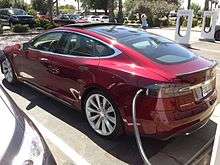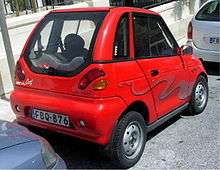Zero-emissions vehicle

A zero-emissions vehicle, or ZEV, is a vehicle that emits no exhaust gas from the onboard source of power.[2][3] Harmful pollutants to the health and the environment include particulates (soot), hydrocarbons, carbon monoxide, ozone, lead, and various oxides of nitrogen. Although not considered emission pollutants by the original California Air Resources Board (CARB) or U.S. Environmental Protection Agency (EPA) definitions, the most recent common use of the term also includes volatile organic compounds, several air toxics (most notably 1,3-Butadiene), and global pollutants such as carbon dioxide and other greenhouse gases.[4]
Examples of zero emission vehicles include muscle-powered vehicles such as bicycles; electric bicycles; gravity racers; battery electric vehicles, which may shift emissions to the location where the electricity is generated (if the electricity comes from coal or natural gas power plants--as opposed to hydro-electric or nuclear power plants);[5] and fuel cell vehicles powered by hydrogen. Emissions from the manufacturing process are thus not included in this definition, and it has been argued that the emissions that are created during manufacture are of an order of magnitude that is comparable to the one of the emissions that are created during a vehicle's operating lifetime.[6][7] However, these vehicles are in the early stages of their development; the manufacturing emissions may decrease by the development of technology, industry, and shifting toward mass production.
Technology and industry


Well-to-wheel emissions
The term zero-emissions or ZEV, as originally coined by the California Air Resources Board (CARB), refers only to tailpipe pollutants from the onboard source of power. Therefore, CARB's definition is accounting only for pollutants emitted at the point of the vehicle operation, and the clean air benefits are usually local because depending on the source of the electricity used to recharge the batteries, air pollutant emissions are shifted to the location of the electricity generation plants.[8] In a broader perspective, the electricity used to recharge the batteries must be generated from renewable or clean sources such as wind, solar, hydroelectric, or nuclear power for ZEVs to have almost none or zero well-to-wheel emissions.[8][9] In other words, if ZEVs are recharged from electricity generated by fossil fuel plants, they cannot be considered as zero emissions.[10]
However, the spread of electrical-powered vehicles can help the development of systems for charging the EV batteries from excess electricity which cannot be used otherwise. For instance, electricity demand is the lowest at nights and the excess generated electricity at this time can be used for recharging the EVs' batteries. It's worth mentioning that renewable sources such as wind turbines or nuclear power plants are less controllable in terms of the amount of generated electricity compared to fossil fuel power plants; most of renewable energy sources are known as intermittent energy sources. Therefore, development of these resources will lead to excess energy which can be better used by development of EVs.[11] Moreover, most of EVs benefit from regenerative brakes and other optimization systems which increases the energy efficiency in these vehicles.
Fuel Cell Vehicles (FCVs), can help even more in terms of the development of sustainable energy sources because these cars use Hydrogen as their fuel. Hydrogen can be used as an energy storage element while electricity is an energy currency which barely be stored, only small amount of electricity can be stored in batteries. The Hydrogen can be produced by electricity through electrolysis, and this electricity can come from green sources. Hydrogen can be produced in situ, e.g.excess at wind farm when the generated electricity is not needed, or it can be connected to the grid to use the excess electricity from the grid and produce electricity, e.g. at Hydrogen pump stations. As a result, development of FCVs can be a big step toward sustainable development and reducing GHG emission in long term perspective.[12]
Other countries have a different definition of ZEV, noteworthy the more recent inclusion of greenhouse gases, as many European rules now regulate carbon dioxide CO2 emissions. CARB's role in regulating greenhouse gases began in 2004 based on the 2002 Pavley Act (AB 1493), but was blocked by lawsuits and by the EPA in 2007, by rejecting the required waiver. Additional responsibilities were granted to CARB by California's Global Warming Solutions Act of 2006 (AB 32), which includes the mandate to set low-carbon fuel standards.[8]
As a result of an investigation into false advertising regarding "zero-emissions" claims, the Advertising Standards Authority (ASA) in the UK ruled in March 2010 to ban an advertisement from Renault UK regarding its "zero-emissions vehicles" because the ad breached CAP (Broadcast) TV Code rules 5.1.1, 5.1.2 (Misleading advertising) and 5.2.1 (Misleading advertising- Evidence) and 5.2.6 (Misleading advertising-Environmental claims.)[13]
Greenhouse gasses and other pollutant emissions are generated by vehicle manufacturing processes. The emissions from manufacture are many factors larger than the emissions from tailpipes, even in gasoline engine vehicles. Most reports on ZEV's impact to the climate do not take into account these manufacturing emissions.[6][7], though over the lifetime of the car the emissions from manufacturing are relatively small [14].
Considering the current U.S. energy mix, a ZEV would produce a 30% reduction in carbon dioxide emissions.[15][16][17] Given the current energy mixes in other countries, it has been predicted that such emissions would decrease by 40% in the U.K.,[18] and 19% in China.[19]
Types of zero-emission vehicles
Apart from animal-powered and human-powered vehicles, battery electric vehicles (which include cars, aircraft and boats) also do not emit any of the above pollutants, nor any CO2 gases during use. This is a particularly important quality in densely populated areas, where the health of residents can be severely affected. However, the production of the fuels that power ZEVs, such as the production of hydrogen from fossil fuels, may produce more emissions per mile than the emissions produced from a conventional fossil fueled vehicle.[22] A well-to-wheel life cycle assessment is necessary to understand the emissions implications associated with operating a ZEV.
Other zero emission vehicle technologies include plug-in hybrids (e.g. ICE/electric battery) when in electric mode, some plug-in hybrids in both recharging and electric mode (e.g. fuel cell/electric battery, compressed air engine/electric battery), liquid nitrogen vehicles, hydrogen vehicles (utilizing fuel cells or converted internal combustion engines), and compressed air vehicles typically recharged by slow (home) or fast (road station) electric compressors, flywheel energy storage vehicles, solar powered cars, and tribrids.
Segway Personal Transporters are two-wheeled, self-balancing, battery-powered machines that are eleven times more energy-efficient than the average American car. Operating on two lithium-ion batteries, the Segway PT produces zero emissions during operation, and utilizes a negligible amount of electricity while charging via a standard wall outlet.[23]
Finally, especially for boats (although Wind-powered land vehicles operating on wind exist (using wind turbine and kite) and other watercraft, regular and special sails (as rotorsails, wing sails, turbo sails, skysails exist that can propel it emissionless. Also, for larger ships (as tankers, container vessels, ...), nuclear power is also used (though not commonly).
Bicycles


In the mid-19th Century bicycle ownership became common during the bike boom predating mass car ownership. In the 1960s, the Flying Pigeon became the single most popular mechanized vehicle on the planet. Some 210 million electric bikes are on the road in China.
Incentives
Subsidies for public transport
Japanese public transport is being driven in the direction of zero emissions due to growing environmental concern. Honda has launched a conceptual bus which features exercise machines to the rear of the vehicle to generate kinetic energy used for propulsion.
Due to the stop-start nature of idling in public transport, regenerative braking may be a possibility for public transport systems of the future.
Subsidies for development of electric cars
In an attempt to curb carbon emissions as well as noise pollution in South African cities, the South African Department of Science & Technology (DST), as well as other private investments, have made US$5 million available through the Innovation Fund for the development of the Joule. The Joule is a five-seater car, planned to be released in 2014.[24]
See also
- List of electric cars currently available
- Future of the car
- Coda Automotive
- GM EV1
- Hybrid vehicle
- Low-carbon fuel standard
- Low emission vehicle
- Miles per gallon gasoline equivalent
- Partial zero-emissions vehicle
- Personal automated transport
- Plug-in hybrid
- Super Ultra Low Emission Vehicle
- Shweeb
- Renault Z.E.
- Tesla Motors
- Tier (emission standard)
- Electric rickshaw
- Ultra Low Emission Vehicle
- Who Killed the Electric Car?, a documentary
- Zero carbon city
- Zero emission
- ZENN (Zero Emission, No Noise)
- Optimal Energy Joule
References
- ↑ PRNewswire (2013-03-28). "And Now There Is One.... Tesla Model S Declared 2013 World Green Car". International Business Times. Retrieved 2013-03-28.
- ↑ California Air Resources Board (2009-03-09). "Glossary of Air Pollution Terms: ZEV". Retrieved 2009-04-21.
- ↑ Christine & Scott Gable. "What is a ZEV - Zero Emissions Vehicle?". About.com: Hybrid Carts & Alt Fuels. Retrieved 2008-04-21.
- ↑ Alternative Fuels and Advanced Vehicles Data Center. "Alternative & Advanced Vehicles: Pollutants and Health". Energy Efficiency and Renewable Energy, US DOE. Retrieved 2009-04-21.
- ↑ "Existing Coal Map - Beyond Coal - Sierra Club". Retrieved 30 May 2015.
- 1 2 Mike Berners-Lee. "Manufacturing a car creates as much carbon as driving it". the Guardian. Retrieved 30 May 2015.
- 1 2 "Calculating the real carbon footprint of vehicles". Retrieved 30 May 2015.
- 1 2 3 Sperling, Daniel and Deborah Gordon (2009). Two billion cars: driving toward sustainability. Oxford University Press, New York. pp. 22 to 26. ISBN 978-0-19-537664-7.
- ↑ David B. Sandalow, ed. (2009). Plug-In Electric Vehicles: What Role for Washington? (1st. ed.). The Brookings Institution. pp. 2–5. ISBN 978-0-8157-0305-1.
- ↑ Palm, Erik (2009-05-01). "Study: Electric cars not as green as you think | Green Tech - CNET News". News.cnet.com. Retrieved 2010-04-18.
- ↑ Lopes, JA Peças, PM Rocha Almeida, and F. J. Soares. "Using vehicle-to-grid to maximize the integration of intermittent renewable energy resources in islanded electric grids." Clean Electrical Power, 2009 International Conference on. IEEE, 2009.
- ↑ Barton, John P., and David G. Infield. "Energy storage and its use with intermittent renewable energy." IEEE transactions on energy conversion 19.2 (2004): 441-448.
- ↑ ASA Adjudication on Renault UK Ltd Archived April 5, 2010, at the Wayback Machine.
- ↑ http://science.howstuffworks.com/science-vs-myth/everyday-myths/does-hybrid-car-production-waste-offset-hybrid-benefits.htm
- ↑ "Plug-in Hybrid Cars: Chart of CO2 Emissions Ranked by Power Source". TreeHugger. Retrieved 2010-04-18.
- ↑ http://www.eia.doe.gov/pub/oiaf/1605/cdrom/pdf/e-supdoc.pdf
- ↑ "Electric Power Monthly -Table 1.1. Net Generation by Energy Source". Eia.doe.gov. Retrieved 2010-04-18.
- ↑ "Less CO2". My Electric Car. Retrieved 2010-04-18.
- ↑ "McKinsey Greater China" (PDF). Retrieved 30 May 2015.
- ↑ Jeff Cobb (2015-12-08). "Nissan Sells 200,000th Leaf Just Before Its Fifth Anniversary". HybriCars.com. Retrieved 2015-12-11. See editorial note.
- ↑ "Power to the people: Nissan and ENEL launch first smart grid trials" (Press release). Paris: Nissan Europe. 2015-12-08. Retrieved 2015-12-11. More than 200,000 Nissan Leafs have been sold worldwide.
- ↑ "MIT study: Hydrogen car no environmental panacea". EurekAlert!. 10 March 2003. Retrieved 30 May 2015.
- ↑ Whitepaper "The Role of the Segway PT in Emissions Reduction"
- ↑ "Environmental Topics & Sustainable Development". Retrieved 30 May 2015.
External links
- Rating, Smog. "DriveClean California". DriveClean. Retrieved 2017-06-08. Official California site on ZEVs and PZEVs
- "Fueling Our Transportation Future". Scientific American. 2006-08-16. doi:10.1038/scientificamerican0906-60. Retrieved 2017-06-08.
- "strategic broker for the clean transportation technology industry". CALSTART. Retrieved 2017-06-08.
- Felix Kramer and Max Baumhefner (March 5, 2013). "Good and Green Reasons to Consider an Electric Car This Year". nrdc.org. Natural Resources Defense Council. Retrieved August 31, 2016.

